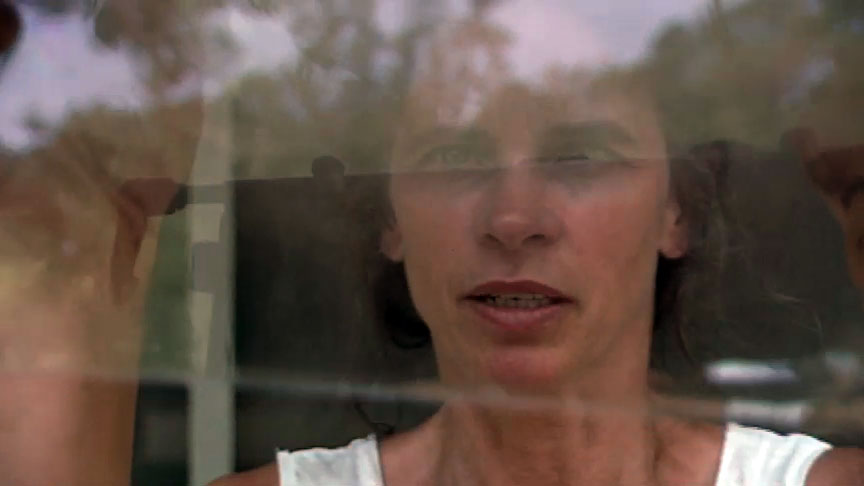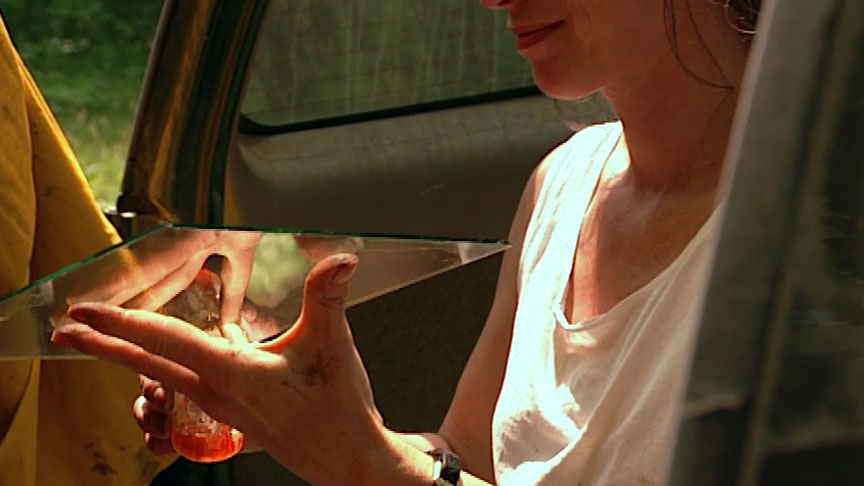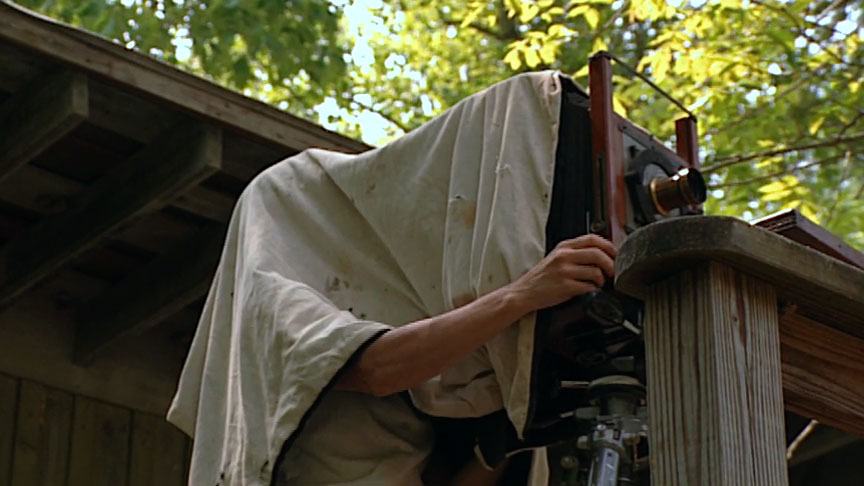Interview
Collodion Process

Sally Mann in her Lexington, Virginia home, 2000. Production still from the "Art in the Twenty-First Century" Season 1 episode, "Place," 2001. © Art21, Inc. 2001.
Sally Mann discusses her photographic process of using collodion, a syrupy solution of nitrocellulose, to prepare a negative.
ART21: Could you take us through some of the steps of your photographic process, especially the collodion process?
MANN: I learned this process from Mark and France Osterman, who are masters. They showed me how to do it correctly, but it’s just that I never am quite able to. I’m sure they’ll be dismayed if they ever see this film. I went to their house, and they walked me through all the steps, and it’s complicated. For starters, it’s hard to get these chemicals. Collodion, ether—they’re all controlled. Of course, grain alcohol you can get, but you can’t get it in Virginia. And the camera—you have to have a separate piece for the camera made, to put the plate in. But once I made up my mind to do it, of course, I pursued it with comical tenacity and got all this stuff pulled together and learned how to do it. It’s not uncomplicated, and it’s sort of a cranky process. It doesn’t allow for much sloppy technique.
For instance, the glass has to be absolutely perfect glass—can’t be just glass you buy at the hardware store, oh no, it has to be framing glass. It has to be perfectly clear glass, and you have to wash it very carefully. You’re not supposed to wash it with this (Windex). You’re supposed to wash it with a special glass wax, and all the chemicals have to be fresh and the water distilled, and so forth. Anyway, to coat the plate: Let’s just say this is the glass. You have to pour the collodion coating, which is collodion and ether mixed together, in one very quick motion. It has to cover evenly, and you have to get it off as fast as you can, otherwise you have streaks. Then you take the plate to the silver nitrate and—for reasons that escape me completely—the silver nitrate sticks to the collodion and ether, and coats it. And at that point, it’s light sensitive. It takes about five minutes. Then you put it in the special back for the camera and carry it dripping to the camera. And you have, at that point, no more than two or three minutes to get the picture before it dries. It dries quickly because the ether and the collodion evaporate. The developer is a mixture of grain alcohol and ferrous sulfate, and the developing is just a repeat of the coating. You basically pour it over the plate. And then you fix it in plain sodium thiosulphate. You can also fix it in (oddly enough) cyanide, but there have been wet-plate-related deaths, due to people drinking their cyanide instead of their grain alcohol.
One of the appropriate metaphoric things in this whole process is that I found out from a doctor that collodion was used in surgery during the Civil War to bind wounds, and I thought, “Oh, how fitting that I should be taking this process to the Deep South.”

Sally Mann in her Lexington, Virginia home, 2000. Production still from the “Art in the Twenty-First Century” Season 1 episode, “Place,” 2001. © Art21, Inc. 2001.
ART21: What triggered the desire to use glass-plate negatives?
MANN: I guess, because I was so immersed in that whole glass-plate, nineteenth-century aesthetic, it was natural to want to learn how to do this. Back in the early ’70s, when we came back from Europe, Larry and I were poking around up in the attic of this five-story building on the [Washington and Lee] campus. And we found this collection of glass negatives that had been taken around Lexington, right after the Civil War, by a local photographer. In fact, he photographed at the cabin, right here on the farm. It was an amazing moment when I held up a glass plate—and damn, it was a picture of the same cliffs that I’ve looked at my whole life, exactly as they are now, even the little vines hanging down. Those same vines are still there. And these ancient arborvitae trees, which obviously had fallen over one hundred years ago—there they were, in the glass plate.
It was a moving thing, to see these images and be able to retrace his steps to a certain extent. He photographed the landscape around here beautifully, and of course it’s the aesthetic I’m most partial to. I love those [John Beasly] Greene pictures, and Gustav LeGray and Atget. I’m surprised it took me this long to get to this process, because I’ve always admired that aesthetic and find it redolent with past. I just need to inject a little of the present in it. Obviously, I don’t want to take the same pictures he took.
ART21: How much time did it take you to master the technique?
MANN: I never mastered it.
ART21: How much practice, then?
MANN: You know, I’m just anal enough—you wouldn’t know it to look at my Hogarthian clutter around here—but I’m just anal enough to find this process satisfying. I can concentrate with gimlet intensity for short periods of time, and pouring the plate is about right for me. I can get the plate coated, which is the important part, that’s the part that you just can’t mess up. And the rest of it didn’t take long at all. It’s just like making every other photograph, really, if you think about it.

Sally Mann in her Lexington, Virginia home, 2000. Production still from the “Art in the Twenty-First Century” Season 1 episode, “Place,” 2001. © Art21, Inc. 2001.
ART21: Could you talk about the equipment you use and why?
MANN: Well, you know, I told you that none of my equipment has ever been any good. I certainly could go out and buy a good, tack-sharp lens that would take the perfect picture, that’s in focus from end to end. But instead, I spend an awful lot of time at that antique mall, looking around for these lenses with just the right amount of decrepitude. The glue has to be peeling off of the lens elements; it’s great if it’s mildewed and out of whack. A lens is made up of several different pieces of glass, which are supposed to stay glued in the right relationship with each other. But my most prized lens has one of the pieces of glass askew, so when the light comes in it, it’s refulgent. It just bounces all around and does this great sort of luminescent thing on the glass. You can tell a good ruined lens, right from the get-go: they are the ones you find in the trash cans of old photo studios, in some ghost town in Iowa. I mean, that’s the kind of lens I’m looking for.
This interview was originally published on PBS.org in September 2001 and was republished on Art21.org in November 2011.



